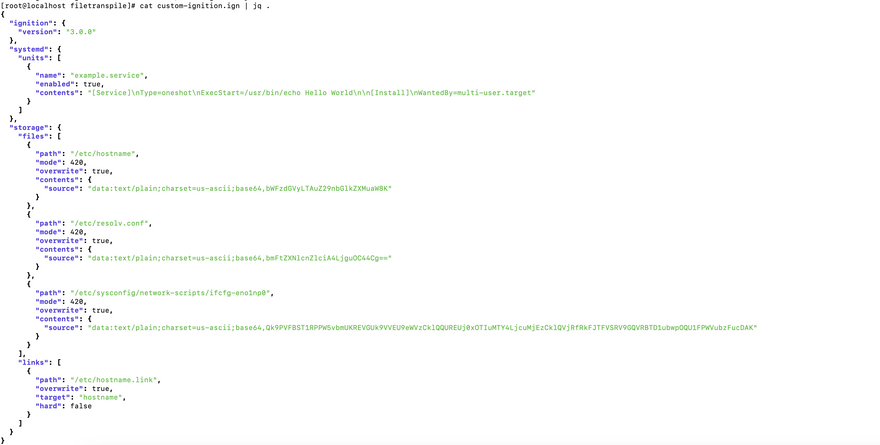Creating Ignition file with filetranspiler tool
In the Openshift UPI deployment method, since we have to generate our ignition config, so to simplify the process, I am going to use the filetranspiler tool for creating custom ignition files. This tool creates an Ignition file from a fake root. Please follow the official GitHub URL for more information.
Installation of filetranspiler tool
The best way to install this project is to run it as a container. So that you can avoid OS-related dependencies.
First, clone the project from GitHub.
git clone https://github.com/ashcrow/filetranspiler.git
- Now, you can run the following command to build the project
podman build . -t filetranspile:latest
Now you can run the filetranspiler as follows, make sure to mount the host directory that has your ignition file and fake root into the container,
podman run --rm -ti --volume `pwd`:/srv:z filetranspile:latest -i install-dir/bootstrap.ign -f bootstrap/fakeroot -o install-dir/custom-bootstrap.ign
You can also create an alias run filetranspiler as generally as follows,
alias filetranspile="podman run --rm -ti --volume `pwd`:/srv:z filetranspile:latest"
filetranspile -i install-dir/bootstrap.ign -f bootstrap/fakeroot -o install-dir/custom-bootstrap.ign
If you do not like the container approach, you can install filetranspiler in Fedora using rpm package manager as follows,
curl -LO https://download.copr.fedorainfracloud.org/results/eminguez/eminguez-RPMs/fedora-33-x86_64/01784152-filetranspiler/filetranspiler-1.1.0-1.fc33.x86_64.rpm
sudo rpm -ivh filetranspiler-1.1.0-1.fc33.x86_64.rpm
Testing filetranspiler tool
Once you have installed this tool, create a fake root directory. Run the following script to test,
mkdir -p fakeroot/etc
echo "master-0.goglides.io" > fakeroot/etc/hostname
ln -s hostname fakeroot/etc/hostname.link
echo "nameserver 8.8.8.8" >fakeroot/etc/resolv.conf
mkdir -p fakeroot/etc/sysconfig/network-scripts
cat <<EOF > fakeroot/etc/sysconfig/network-scripts/ifcfg-eno1np0
BOOTPROTO=none
DEFROUTE=yes
IPADDR=192.168.7.213
IPV4_FAILURE_FATAL=no
NAME=eno1np0
EOF
At the end of this script, your folder structure should look like this,
tree fakeroot
Now we need a startup ignition.json to test; let's create a test file as follows,
cat <<EOF > ignition.json
{
"ignition": { "version": "3.0.0" },
"systemd": {
"units": [{
"name": "example.service",
"enabled": true,
"contents": "[Service]\nType=oneshot\nExecStart=/usr/bin/echo Hello World\n\n[Install]\nWantedBy=multi-user.target"
}]
}
}
EOF
Once your directory structure is in place, then use filetranspiler binary to create your custom ignition.
filetranspile -i ignition.json -f fakeroot -o custom-ignition.ign
This will create a custom-ignition.ign file with the following content,
cat custom-ignition.ign | jq .
If you want to see a pretty output on-screen, use the following command.
filetranspile -i ignition.json -f fakeroot -p
To know more about this tool, run the help menu,
filetranspile --help
usage: filetranspile [-h] [-i IGNITION] -f FAKE_ROOT [-o OUTPUT] [-p]
[--dereference-symlinks] [--format {json,yaml}]
[--version]
optional arguments:
-h, --help show this help message and exit
-i IGNITION, --ignition IGNITION
Path to ignition file to use as the base
-f FAKE_ROOT, --fake-root FAKE_ROOT
Path to the fake root
-o OUTPUT, --output OUTPUT
Where to output the file. If empty will print to
stdout
-p, --pretty Make the output pretty
--dereference-symlinks
Write out file contents instead of making symlinks
NOTE: Target files must exist in the fakeroot
--format {json,yaml} What format of file to write out. `yaml` or `json`
(default)
--version shows the program's version number and exit
Now we know how to generate custom ignition files, let's move to the next topic.








Top comments (0)